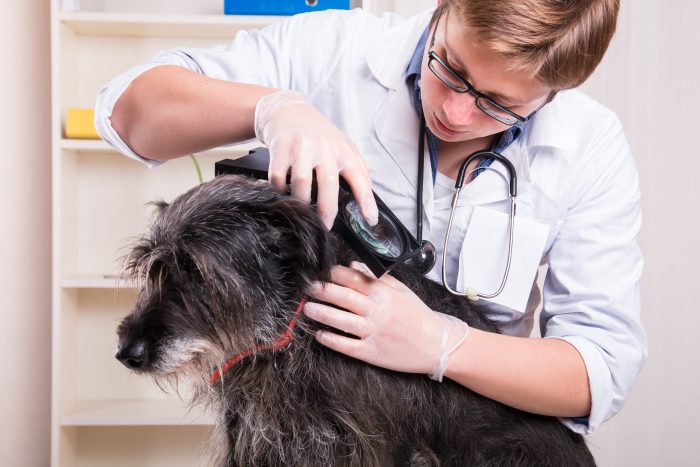Just as people are faced with arthritis and joint disease, our canine companions may also develop some form of degenerative joint disease over the course of their lifetime. Specifically, inflammatory joint disease (although not as common as other forms of canine joint disease) can be a real threat to your dog’s health.
Therefore, it’s important as a pet owner to be aware of the risks and joint pain relief measures you can take to protect your beloved pooch from inflammatory canine arthritis. Although there are several causes for this sometimes debilitating condition, including bacterial/fungal infections, Rocky Mountain Spotted Fever, or a hereditary defect in your dog’s immune system, the two primary causes of inflammatory joint disease in arthritic dogs are Lyme disease and rheumatoid arthritis.
Causes of Lyme Disease
Although Lyme disease has become a widespread problem for animals and their human counterparts since the mid-80s, it can be managed if caught early on. Initially recognized in dogs in 1985, this tick-borne disease is actually caused by a type of bacteria (known as spirochete Borrelia burgdorferi) that the common deer tick carries and passes on to its host.
Even though the disease has been documented in individuals from all 50 states, it is endemic primarily in the Northeast and upper Midwest regions of the United States. If left untreated, your dog may be at risk for the complications of Lyme disease, which can include inflammatory joint disease symptoms that affect him for the duration of his lifespan.
However, if you’re diligent in checking your dog for ticks and tick bites – particularly if he spends any amount of time outside during the summer months – you can ensure his safety and protect him from this harmful disease.
Lyme Disease Transmission and Life Cycle
The actual life cycle of the deer tick itself has a defining role in infecting your pet. Because the eggs hatch into larvae in the spring, the summertime is when the larvae will feed on the initial host, typically a small mammal such as a white-footed mouse.
From there, the infected larva will last throughout the winter until the following spring, when it becomes a nymph and continues to feed, primarily on mammals such as a deer, dogs, or humans. Keeping this in mind, infections primarily occur during the warmer months. Therefore, you should closely inspect yourself, family members, and pets for tick bites or infestation.
Although an infected dog may not pose a risk to other members of your household, it is important to be aware of even one single tick, as a tick that hasn’t received a complete meal upon attachment may seek out a human (or other pet) and bite them, causing possible infection. It typically takes about 48 hours for the the disease to be transmitted from the tick to the host animal.
Signs & Symptoms of Lyme Disease
Recognizing Lyme disease can be tricky as the illness takes about 2-5 months to manifest after your dog is bitten by an infected tick. Although studies have shown a number of different canine forms of the disease, the most common symptoms include joint swelling, a fever between 103 and 105°, lethargy, loss of appetite, and swollen lymph nodes.
Although not as frequent, there have been some cases in which dogs will develop kidney disease, heart problems or nervous system complications after being infected with Lyme disease. Therefore, it is of utmost importance for pet owners to take their dog to the vet for a full blood and urinalysis if they have tested positive for Lyme disease.
A thorough battery of tests can properly assess your pet’s organ functions and determine the best course of treatment, depending on the severity of complications.
Did you know: Although there have been cases of cats contracting Lyme disease, it rarely occurs among the species, even in endemic areas. Other domestic animals, such as horses, have been known to develop the disease, but it does not seem to pose a serious problem. Another interesting fact worth noting: dogs do not develop the ‘bull’s-eye’ circular rash on the skin, which is typically found on people who are bitten and test positive for Lyme.
Preventative Measures for Lyme Disease: Vaccination, Tick Control, & Insecticides
There are a number of preventative measures you can take to protect your four-legged friend from the perils of Lyme disease. It’s also important to keep in mind that just because your dog was infected with Lyme once before, doesn’t mean he can’t become re-infected – so he still needs protection.
According to studies, dogs who have been vaccinated are less likely to contract Lyme disease than unvaccinated animals. However, there are some vets who have criticized the vaccines and do not recommend their usage.
Your dog may receive vaccination for Lyme disease after 12 weeks of age, and your vet will administer follow-up doses and annual boosters after his initial shot. In order to avoid complications associated with over-vaccination, experts recommend only vaccinating dogs who live in areas where Lyme disease is prevalent.
One of the most effective ways of prevention for you and your pet is the immediate removal of the insect if they become attached to you or your dog’s skin. Besides Lyme disease, ticks carry a host of other diseases that may be transmitted to you and your family.
An easy way to avoid contact with ticks: steer clear of outdoor areas that are heavily overgrown with grasses or other foliage, particularly in the warmer months. Inspect yourself and your dog carefully for ticks after every outing.
Administering insecticides is another method of prevention, including once-a-month topical treatments and specially-formulated flea and tick repellant collars that you can use at home to protect your dog.
As with any treatment, be sure to consult with your veterinarian to discuss the safest brands and proper administration of any insecticide or related product on your pet.
Diagnosis & Treatments for Lyme Disease
If you believe your dog has been infected with Lyme disease, your vet will administer a blood test in order to make a comprehensive and accurate diagnosis. Once it has been determined he has the disease, your vet will prescribe a course of antibiotics which must be administered exactly as prescribed in order to ensure optimally effective results.
Although some arthritic dogs have been known to develop chronic infections, the majority of healthy dogs recover fairly quickly and respond positively to this course of treatment, particularly if pet owners are able to diagnose the symptoms and seek treatment early on.
Causes of Rheumatoid Arthritis
Rheumatoid arthritis (RA) is an autoimmune disease, meaning that it is caused by an overreaction of the immune system. Found in dogs as well as their human counterparts, this debilitating disease is seen most often in small or toy breeds of dogs, typically between 5 – 6 years of age, but is found occasionally in larger breeds as well.
Rheumatoid arthritis occurs when a dog’s immune system mistakes some of his body’s own protein for a foreign substance, attacking the ‘threatening’ protein substance with antibodies. A self-perpetuating process, the dog’s immune system ultimately wears away the cartilage and bones within the affected joints over time.
Although there is no known cure, it’s important to take action if you believe your dog is suffering from rheumatoid arthritis. With proper diagnosis and treatment, you can help maintain your dog’s quality of life, preventing ailments such as hip dysplasia.
As a dog owner, educating yourself as much as possible can help you to become an advocate for your pooch’s health and overall well-being, whether it involves monitoring his weight, diet, exercise routine, or implementing other recommendations given by your veterinarian.
Signs & Symptoms of Rheumatoid Arthritis in Dogs
Symptoms of rheumatoid arthritis in dogs range from stiffness in joints to an inability to walk. However, the most common symptoms include: loss of appetite, fever, swollen/painful joints, and enlarged lymph nodes. In severe cases of rheumatoid arthritis in dogs, owners have reported tonsillitis, pneumonia, and kidney disease.
Generally, dogs with RA have several problematic joints affected by the disease, and may or may not be lame – this may range from mild difficulty with walking to a complete inability to do so. Additionally, lameness may shift from leg to leg, and may come and go. Because the arthritic joints that are affected are swollen and painful, there may be a loss of muscle tissue in that limb, particularly if the lameness has been ongoing for a length of time.
If you recognize any of these signs in your pup or older dog, be sure to visit your vet promptly for a full examination. If inflammation goes unchecked, it can cause damage to cartilage and muscle tissue. Your vet will administer the proper tests for an accurate prognosis, and if he is positive for RA, prescribe an anti-inflammatory for dogs as well as other care regimens to relieve and manage your pet’s symptoms.
Diagnosis & Treatments for Canine Rheumatoid Arthritis
Once your vet has conducted a thorough physical on your dog, he will most likely take radiographs (x-rays) to confirm the disease. Typically, skeletal abnormalities associated with RA are clearly recognizable, including bony spurs, irregular joint surfaces and the appearance of holes in the bone itself.
In addition, your vet will run special blood tests to identify the rheumatoid factor, which may or may not be present. Other tests may include analyzing your dog’s synovial fluid, which is the fluid found in your dog’s joints. Specific changes characteristic of RA may be found in the sample fluid, including a cloudy appearance (healthy fluid is clear) and increased inflammation found on a cellular level.
Your vet may also run biopsies of tissues found within the joint to determine the presence of RA. After compiling this comprehensive group of tests, your veterinarian will use your dog’s history, past/present physical exams, and test results to arrive at a positive diagnosis for rheumatoid arthritis.
Ensuring that your furry friend gets plenty of rest, has a gentle exercise routine (short daily walks are usually encouraged as a form of physical therapy), and a weight management plan can help to alleviate many of his symptoms. Your vet may prescribe a special diet or suggest a particular brand of food if your dog is overweight, since additional pounds put added stress on already damaged joints.
In addition, there are more natural remedies for dog arthritis. Research has shown that certain fatty acid supplements, like fish oil, may help reduce the joint inflammation associated with RA; ask your vet or pet supply store for brand suggestions. As always, be sure to consult with your veterinarian when administering any type of treatment to your dog.
Helpful Tips:
If your dog is suffering from rheumatoid arthritis, you may wish to incorporate the following suggestions into your daily routine:
- A home fit for your hound: For dogs who have difficulty climbing, you may wish to get a ramp to get in and out of the car, up and down stairs, etc. You may also wish to put down carpet runners on slick floors to avoid slip-and-fall accidents.
- Four paws on the floor: Booties provide extra grip for dogs on all surfaces, further preventing faulty footing.
- Doggy dreams: Finding a comfortable bed for your dog can alleviate pressure points and ensure a restful night’s sleep.
Long-Term Prognosis for Dogs with Rheumatoid Arthritis
Unfortunately, there is no known cure for RA, either in dogs or humans. As a pet owner, the most effective thing you can do for your four-legged friend is to manage his symptoms while preventing further wear and tear on his joints.
This includes weight control, developing a safe exercise routine, and being mindful of his condition in order to maximize his mobility while protecting him from unnecessary pain or injury. Making your dog as comfortable as possible is ultimately the best medication you can provide.











